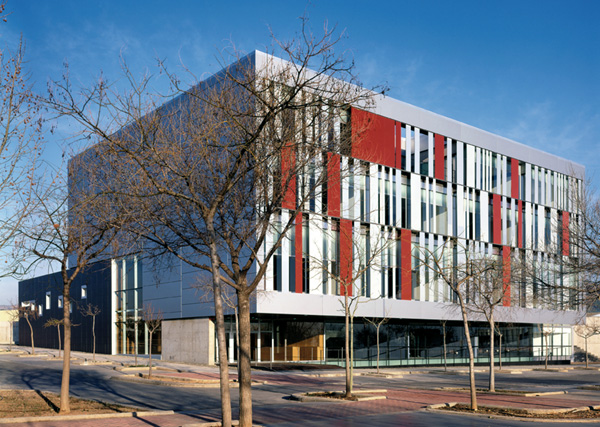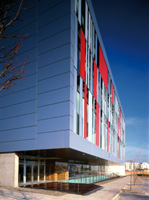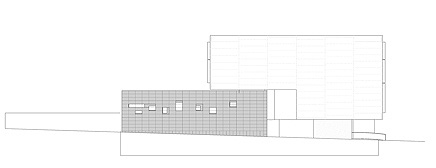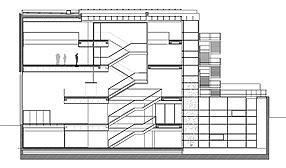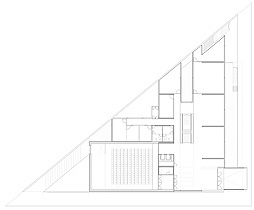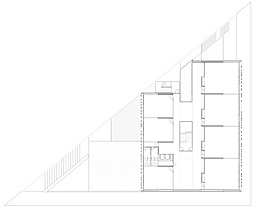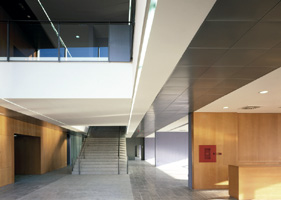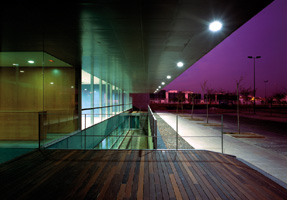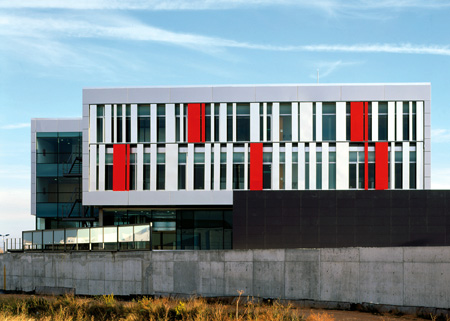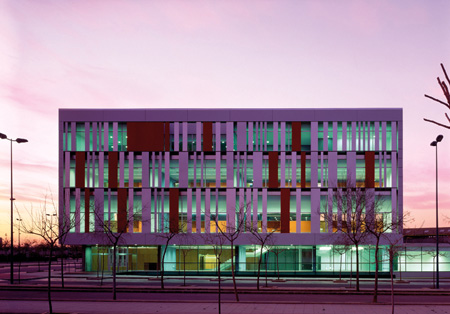Desde el Lugar
El Proyecto se plantea desde el
reconocimiento de la necesidad de asumir el compromiso social que la
Universidad debe de tener con la Sociedad en la que reside.
Proponemos un edificio que sea capaz
de transmitir un imagen nítida y diferenciada en el Campus. Un edificio que
articule sus actividades y las ponga al servicio de la Sociedad ...
Aceptamos la trama reticular del
Campus como elemento ordenador del proyecto. Nuestra parcela se encuentra en
el límite del recinto universitario y tiene una traza triangular provocada
por un reajuste en el perímetro del lado Norte del Campus. Se trata
de una parcela residual.
El edificio se ajusta a la alineación
ortogonal definida por los lados Sur y Este de la parcela, dejando un patio
triangular en el Norte.
|
Place
The approach to this project is based on
recognising that the University should have a social commitment to the
local community and needs to address this commitment.
We propose a building that will convey a
clear image, differentiated from the rest of the campus, a building that
will articulate its activities and place them at the service of society.
We accept the reticular grid of the campus
as an organising element of the project. The triangular shape of the plot,
a marginal site on the edge of the campus, is the result of a readjustment
of the University's northern perimeter.
The building is placed along the
right-angled alignment defined by the southern and eastern sides of the
plot, with a triangular courtyard on the northern side.
|
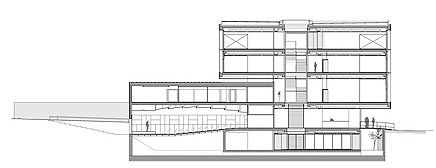
|
|
Proponemos, por tanto, dos volúmenes
perpendiculares que se encuentran en el vértice S-E de la parcela
reforzando su único ángulo recto: en ese punto ubicamos el acceso.
Los dos volúmenes están
perfectamente diferenciados, tanto por su dimensión como por su definición
material. El de menor altura se ajusta a la calle longitudinal (Sur) que es
paralela al boulevard y se materializa mediante un revestimiento de placas
de gres porcelánico (1,20x0,60 m) de color negro y textura mate y lisa. El
volumen de dimensión mayor se apoya en el anterior y se gira sobre el lado
Este para mostrar la fachada de mayor altura como el frente principal del
conjunto. En este caso se materializa con un revestimiento de planchas de
aluminio anodizado en su color natural para definir los testeros Norte y Sur
y un sistema de planos acristalados con una protección de lamas de paneles
de aluminio verticales que configuran las fachadas Este y Oeste.
El conjunto volumétrico se percibe
claramente diferenciado destacando sobre la contundencia ciega del volumen
negro la ligereza de las fachadas Este (tres alturas) y Oeste (dos alturas),
que vibran debido al sistema de combinación de las lamas verticales en el
que se ha incorporado de forma aleatoria el color rojo del logotipo de la
Universidad de Castellón.
Desde el Programa
Desde el punto de vista
estrictamente funcional, los dos volúmenes diferenciados corresponden a las
distintas agrupaciones de actividades del complejo programa del edificio.
En el volumen negro se ubican todas
las actividades relacionadas con la Institución (salón de actos, sala de
reuniones, oficinas del Consejo Social, etc..); en el volumen metálico se
articulan todas las actividades de Postgrado (seriación de aulas,
seminarios y tutorías).
Estas actividades docentes se
distribuyen a ambos lados de un estrecho patio longitudinal acristalado de
tres metros de anchura - paralelo a la fachada principal y abierto al Norte
- donde se alojan las escaleras y los vacíos de comunicación visual entre
los distintos niveles.
Debido a su estratégica ubicación
y a su transparencia, el interior del edificio se percibe como un complejo
sistema de relaciones en el que las escaleras adquieren un significado
especial como mecanismo de comunicación y articulación vertical del
conjunto.
El patio triangular definido por la
articulación de los dos volúmenes queda en la planta primera y se vincula
directamente a las actividades del Consejo Social.
|
Consequently, we propose two perpendicular
blocks that meet at the S-E vertex, reinforcing the plot's single right
angle. The entrance is placed at this point.
The two volumes are perfectly
differentiated by their dimensions and material definition. The lower of
the two is sited on the south side, along the longitudinal street that
runs parallel to the boulevard, and clad with smooth matt black porcelain
stoneware slabs (1.20 x 0.60 m). The larger block, supported by the lower
one, turns east to present its higher face as the main façade of the
whole. In this case, the materialisation is a cladding of plain anodised
aluminium plates to define the north and south ends and a system of glazed
surfaces protected by vertical aluminium slats on the east and west façades.
The volumes are clearly differentiated: the
blank forcefulness of the black block highlights the lightness of the east
façade (three storeys) and west façade (two storeys)of the other, a
vibrant combination of vertical slats with a random arrangement of the red
of Castellón University's logo.
Brief
From a purely functional point of view, the
two differentiated blocks respond to the different groupings of activities
in the building's complex brief.
The black block houses all the
Council-related activities (assembly hall, meeting rooms, Social Council
offices, etc.), while all the Postgraduate activities are articulated in
the metal block (seriation of lecture halls, seminar rooms and tutorial
rooms).
These teaching activities are arranged on
either side of a narrow longitudinal glazed courtyard, three metres wide,
parallel to the main façade and open to the north, which accommodates the
staircases and the open spaces for visual communication between the
different storeys.
Because of its strategic location and
transparency, the interior of the building is perceived as a complex
system of relations in which the staircases acquire a special meaning as
devices for communication and vertical articulation of the whole.
The triangular courtyard outlined by the
articulation of the two volumes is at first storey level and is directly
linked to the activities of the Social Council.
|
|

